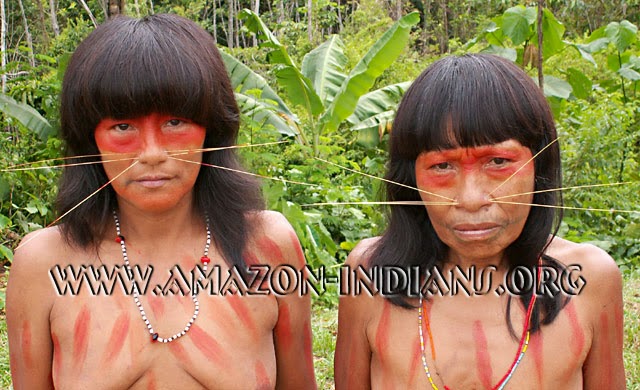Scarification in Africa
Scarification in Africa is quite often geometric, made of repetitive patterns, is symbolic and has spiritual meanings.
Women will often go through scarification as it shows that they can take pain, and that their body is ready for childbirth.
Facial scarification is often used for identification and can show class and rank in the community.
Scarification is also used as a differentiation between the "Natural" and "civilized" self.
Nuba People
 |
| Leni Riefenstal, (unknown date), A girl with very strong marked decoration scars. [ONLINE]. Available at: http://www.leni-riefenstahl.de/eng/dienuba/8_1.html [Accessed 15 October 14]. |
Amongst women, different areas are scarred at different ages; 10 years old: Front. Menstration: Breasts. Childbirth: Back and legs.
Shilluk People
Shilluk scarification mainly consists of 'dots' along the forehead above the brow.
 |
| unknown, (unknown date), Shilluk man, South Sudan. [ONLINE]. Available at: http://www.paulbanksphoto.com/files/GALLERY%201/Gallery-01_45.jpg [Accessed 15 October 14]. |
DR Congo- Luva people
Scars are added in memory, and are built upon as time goes on. The body becomes a canvas for their narrative.
DR Congo- General ideas
The scars act almost as a form of communication as it allows people to read each others stories. These feature some of the most complex designs in African scarification, and in many Congolese tribes only the women are powerful enough to hold the power of the gods, so they will be scarred.
Yoruba People
The body is used as a reflection of inner qualities, emotions and experiences. They are worn with prode, and show symbols of bravery, grief or religion. Practitioners show loyalty to Ogin, the god of iron. Some markings are known as 'Kolo' markings, and were originally to show that a woman can take pain, but have now become more fashion based.
 | |
| Middle-Africa.com, (Unknown date), Yoruba woman Scarification [ONLINE]. Available at: http://www.middle-africa.com/uploads/1236082706-fb115f67xr.jpg [Accessed 25 October 14]. |
The Omo people are considered to be one of the most adorned people. There can be Mursi scarification that can be records of personal achievements, but as with many African scars they can have no meaning at all. For Suri men, scars can represent those he's killed, and therefore represent feats of bravery or skill. They still scar today.
 | |
| omovalley.com, (1800), A man of the Mursi Tribe [ONLINE]. Available at: http://www.omovalley.com/images/A%20man%20of%20the%20Mursi%20Tribe.jpg [Accessed 25 October 14]. |
Piercings in Africa
Makonde lip plates were more of a plug than a plate:
 |
| ezakwantu.com, (unknown date), Makonde Woman - Circa 1910 [ONLINE]. Available at: http://www.ezakwantu.com/Lip%20Plug%20African%2002.jpg [Accessed 25 October 14]. |
Neck Rings- Ndebele Women.
 | |
| Krugerpark.co.za, (unknown date), Ndebele Woman [ONLINE]. Available at: http://www.krugerpark.co.za/images/Ndebele-Woman-adornment-590.jpg [Accessed 25 October 14]. |
Mangbetu
'True' mangbetu people, especially in the upper classes will elongate their sculls and accentuate this with hair styles. This process is known as Lipombo, and starts at a young age where the parent will tightly wrap cloth around a child's head. It is thought that this is done to make more room for knowledge, and is a status symbol. This process was banned in the 1950s.
India
Apatani women have large nose plugs, and these are thought to have originated as a deterrent from kidnap. The tattoos women have are also traditional, but this has stopped since the 1970s.
 | |
| Brent Lewin Photography. 2014. Brent Lewin Photography. [ONLINE] Available at: http://www.brentlewin.com/#/stealing-beauty/the-apatani/Apatani_02. [Accessed 25 October 2014]. |
Burma
Kayan people use neckrings to give the ideal of a swan-like, elegant neck that promotes femininity. These rings push the collar bones down to make the neck longer, and instead of being separate rings, it is one coil around the neck. There is increasing pressure to apply this alteration to younger generations due to tourism.
In Japan women blacken their teeth using iron filings in an acidic mixture of tea, vinegar and rice wine. This was commonly used in brothels and is therefore highly sexualised. This is usually first applied before the woman entered her husbands home, and can only be reversed by an empress.
Vietnamese women blacken teeth to mark their coming of age. This is used as a form of dentistry, as it forms a protective layer over the enamel.
 | |
| Uwe Strasser, (2007), Black and White [ONLINE]. Available at: https://www.flickr.com/photos/herruwe/1391829323/ [Accessed 25 October 14]. |
In Indonesia they chisel their teeth. It is thought that chiselling their teeth will keep the spirits at bay. Natural teeth are thought to be a bad omen.
 | |
| unknown, (unknown date), Mentawai Woman flashing her pearly, chiseled whites. [ONLINE]. Available at: http://idigculture.com/wp-content/uploads/2014/04/teeth-300x210.jpg [Accessed 25 October 14]. |
The Han Chinese would bind their feet using rope to fit into the 'Lotus' shoe. The smallest shoe is the 'Golden Lotus'The smaller the foot the more feminine, and the better. This was banned by the communist government.
 | ||
| unknown, (unknown date), Han Chinese foot binding [ONLINE]. Available at: http://academic.mu.edu/meissnerd/wagner1.gif [Accessed 25 October 14]. |
Matses and Matis
The Matses have long 'whiskers' and the Matis have short black whiskers.
 | |
| Amazon-Indians native tribe, (2005), Matses with whiskers [ONLINE]. Available at: http://www.amazon-indians.org/matses/19-Matses-Women2.jpg [Accessed 25 October 14] |
Rikbaktsa People
The Rikbaktsa people are from Brazil. They can change their names at various stages in their lives, and this was traditionally marked by a new piercing,
The Mayan people have an estimated population of 7 million people. They are thought to have also shaped their skulls, like the Mangbetu people of Africa.










No comments:
Post a Comment